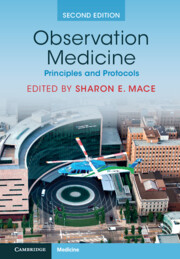
- Publisher:
- Cambridge University Press
- Online publication date:
- June 2025
- Print publication year:
- 2025
- Online ISBN:
- 9781009039215
- Subjects:
- Emergency Medicine, Medicine, Internal Medicine

Using comprehensive sample administrative and clinical protocols, this fully updated and practical second edition guide to observation medicine (OM) provides a detailed account of how to establish and run an observation unit (OU) and reviews medical/surgical/obstetrical-gynecologic/psychiatric/social conditions in which OM may be applicable. The book covers clinical topics including improving patient outcomes, avoiding readmissions, and using OM in a pandemic or disaster. Practical topics on design, staffing, and daily operations; fiscal and business aspects, such as coding, billing, and reimbursement; regulatory concerns such as aligning case management and utilization review with observation; nursing considerations are all present. The new edition features many new chapters and topics ranging from the geriatric OU, psychiatric observation, telemedicine in OM, to the cancer patient in the OU. Applicable to an international audience, it offers instructions for implementing observation in any setting or locale and in any type of hospital or other appropriate facility.
 Loading metrics...
Loading metrics...
* Views captured on Cambridge Core between #date#. This data will be updated every 24 hours.
Usage data cannot currently be displayed.
The PDF of this book is known to have missing or limited accessibility features. We may be reviewing its accessibility for future improvement, but final compliance is not yet assured and may be subject to legal exceptions. If you have any questions, please contact accessibility@cambridge.org.
Allows you to navigate directly to chapters, sections, or non‐text items through a linked table of contents, reducing the need for extensive scrolling.
Provides an interactive index, letting you go straight to where a term or subject appears in the text without manual searching.
You will encounter all content (including footnotes, captions, etc.) in a clear, sequential flow, making it easier to follow with assistive tools like screen readers.
You will still understand key ideas or prompts without relying solely on colour, which is especially helpful if you have colour vision deficiencies.